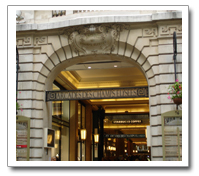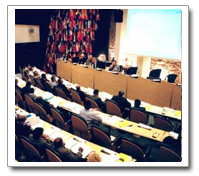ATA Available Technologies
The Agricultural Research Service
List of available Technologies
Disclaimer: ARS will make every effort to keep this list up to date by removing any technologies that have been licensed by a company or University. The technologies listed are in various stages of the patent process so only limited information can be presented. For further information or researcher contact for any of the technologies listed please contact:
Thomas Moreland, Office of technology Transfer
thomas.moreland@ars.usda.gov
301-504-4838
- ANTIMICROBIAL PEPTIDES:
- ARS Docket Number: U113.08 TRIPLE ACTING ANTIMICROBIALS THAT ARE REFRACTORY TO RESISTANCE DEVELOPMENT
U113.08 US Patent App: 12/874,138. These antimicrobials were designed to be refractory to resistance development. The protein/sequences covered in this application include p181 (also called 155Lyso-390lysK-LysoSH3b), the protein which appear to be the most active in nasal infection eradication. The use of three concurrent lytic activities predicts that these antimicrobial agents will be refractory to resistance development, in that bacteria are rarely able to evade three lytic activities simultaneously.
- ARS Docket Number: U34.09 FUSION OF A PROTEIN TRANSDUCTION DOMAIN TO PEPTIDOGLYCAN HYDROLASE ENZYMES ALLOWS DELIVERY OF PROTEIN ANTIMICROBIALS TO INTRACELLULAR PATHOGENS
U34.09 US Patent app: 12/784,675. This invention disclosure expands on these triple acting fusion proteins by adding a ~13 amino acid protein transduction domain (PTD) from the HIV-TAT protein. The addition of the PTD to the PG hydrolase fusions will still allow eradication of extracellular Staphylococcus aureus, but will also kill intracellular forms of the pathogen.
- ARS Docket Number: U130.09 NOVEL ANTI-INFECTIVE PEPTIDE WITH DIRECT KILLING EFFECT AGAINST INVASIVE STAGES OF EIMERIA, NEOSPORA AND CRYPTOSPORIDIA PARASITES
U130.09 US Patent app: 13/071,112 This invention describes a novel lytic peptide (cNK-2) derived from chicken NK lysin which has a direct killing activity against multiple Eimeria species as well as against other apicomplexa parasites including Neospora and Cryptosporidia.
- ARS Docket Number: U53.09 NOVEL ANTIBACTERIAL OLIGOPEPTIDE PRODUCED BY A LACTOBACILLUS STRAIN VIA FERMENTATION
U53.09 US Patent app: 12/888,541 The invention is a novel antibacterial oligopeptide naturally produced by a new isolate of a Lactobacillus species which has antibacterial activity against a range of bacteria including the food-borne pathogens Listeria monocytogenes, the opportunistic pathogens Staphylococcus aureus and Enterococcus faecalis, plus several other Gram-positive Lactobacillus species which cause stuck fermentations in bio-ethanol production facilities
- ARS Docket Number: U113.08 TRIPLE ACTING ANTIMICROBIALS THAT ARE REFRACTORY TO RESISTANCE DEVELOPMENT
- PREBIOTICS:
- ARS Docket Number: U161.03 IMMUNOPOTENTIATING EFFECT OF A FOMITELLA FRAXINEA DERIVED LECTIN OF CHICKEN IMMUNITY AND RESISTANCE TO COCCIDIOSIS
U161.03 US Patent No: 7,438,915 This invention reports a novel immunopotentiating effect of a lectin (FFrL) extracted from the mushroom Fomitella fraxinea on poultry intestinal immunity and poultry coccidiosis. The treatment regimen could involve oral feeding, intramuscular injection or intravenous injection.
- ARS Docket Number: U55.02 PREBIOTIC OLIGOSACCHARIDES VIA ALTERNANSUCRASE ACCEPTOR REACTIONS
U55.02 US Patent No: 7,182,954 . Oligosaccharides produced by an alternansucrase enzyme catalyzed reaction of sucrose with an acceptor oligosaccharide are effective as prebiotics for controlling enteric bacterial pathogens. Populations of enteropathogenic bacteria may be substantially reduced or inhibited by treatment of an animal with a composition comprising one or more of these oligosaccharides in an amount effective to promote the growth of beneficial bacteria. The method is particularly effective for the control of Salmonella species, enteropathogenic Escherichia coli, and Clostridia perfringens.
- ARS Docket Number: U128.02 USE OF 2-NITROPROPANOL, 2-NITROETHANE AND 2-NITROETHANOL FOR CONTROL OF MICROBIAL PATHOGENS
U128.02 US Patent No: 7,176,244 The invention provides a method and compositions for controlling food borne enteric bacterial pathogens in animals. Populations of enteropathogenic bacteria may be substantially reduced or elimiated by treatment of animals with an effective amount of 2-nitropropanol, 2-nitroethane or 2-nitroethanol. The compounds may be administrered orally, providing a reduction in the populations of the enteropathogenic bacteria in the alimentary tract of the animal, or they may be applied externally onto the animal to reduce the populations of any such bacteria which may be present as contaminats on the surface of the animal.
- ARS Docket Number: U180.04 CREATING DESIGNER ANTIMICROBIALS: PEPTIDOGLYCAN HYDROLASE MODULE SHUFFLING
U180.04 Patent No. 7,572,602 This invention is a demonstration that 100-200 amino acid peptidoglycan digestion domains can act independent of their protein surroundings, can be shuffled like cars in a train, with the end result yielding a better anti-microbial with broader host range specificity.
- ARS Docket Number: U151.09 CREATING DESIGNER ANTIMICROBIALS: PEPTIDOGLYCAN HYDROLASE MODULE SHUFFLING
U151.09 (divisional of U180.04) US Patent No: 7,982,003 Peptidoglycans are a major structural component of both Gram positive and Gram negative bacterial cell walls. They are the major strength element of the bacterial cell wall, are up to 40 layers thick, and are composed of a complex molecule with a sugar backbone (alternating N-acetyl glucosamine and N-acetyl muramic acid residues). This backbone is cross linked with covalently attached peptides, allowing the bacteria to withstand the 3-4 atmospheres of osmotic pressure that exists across the bacterial cell wall. Although peptidoglycan structure is similar between species, with the oligosaccharide backbone present in all, there is also a great deal of cell wall diversity between different bacterial species.
- ARS Docket Number: U161.03 IMMUNOPOTENTIATING EFFECT OF A FOMITELLA FRAXINEA DERIVED LECTIN OF CHICKEN IMMUNITY AND RESISTANCE TO COCCIDIOSIS
- BACTERIOPHAGE ENDOLYSINS:
- ARS Docket Number: U15.06 Specific lysis of Staphylococcal Pathogens by Bacteriophage PhiLL Endolsin.
A divisional was filed July 27, 2011. U156.11 US Patent No: 8,012,730 Isolated antimicrobials Methods for treating mastitis and compositions. These truncated (or full length) antimicrobials are important because they would be an alternative treatment to the current standard antibiotic treatment for mastitis which is suboptimal. It has been reported that antibiotic treatment of mastitis is less than 50% effective (Deluyker, 2005). Additionally, S. aureus having the ability to go intracellular and thus evade the antibiotic. S. aureus is also a notorious human pathogen with multi-drug resistant strains plaguing clinics world wide. A new antimicrobial to combat this pathogen would be a wonderful addition to the battery of current treatments.
- ARS Docket Number: U64.08 Lambdasa2 endolysin truncation
U64.08 US Patent app: 12/470,321 The LambdaSa2 deletion construct ECC is potent against both MRSA and multiple disease causing streptococcal species. This would be a valued addition to the battery of agents to combat these pathogens.
- ARS Docket Number: U65.08 Lysk endolysin is singergistic with lysostaphin against MRSA
U65.08 US Patent app: 12/470,466 Properties of LysK make it a candidate antimicrobial for treatment of mastitis, especially considering that the current antibiotic treatment for mastitis is reportedly less than 50% effective (Deluyker et al. 2005).
- ARS Docket Number: U112.08 Bacteriophage lytic enzymes as alternative antimicrobials Bateriophage Lytic Enzymes as Alternative Antimicrobials.
U112.08 US Patent app: 12/874,138 The goals of the proposed invention are to develop bacteriophage lytic enzymes as alternative antimicrobials to currently utilized antibiotics in animal feeds. The full-genome sequence of this bacteriophage contains the genetic information for the lytic enzyme genes.
- ARS Docket Number: U15.06 Specific lysis of Staphylococcal Pathogens by Bacteriophage PhiLL Endolsin.
- ANTIVIRALS:
- ARS Docket Number: U35.09 ANTIVIRAL ACTIVITY AGAINST FOOT-AND-MOUTH DISEASE VIRUS BY TYPE III INTERFERON
U35.09 US Patent app: 12/976,129 This invention relates to the discovery and cloning of bovine IL28 (bIL28B), also termed bovine interferon lambda (bIFN-lambda3) and its use as an effective biotherapeutic against foot-and-mouth disease virus (FMDV).
- ARS Docket Number: U114.07 COMBINATION OF INTERFERON ALPHA AND INTERFERON GAMMA CAN SYNERGISTICALLY PROTECT SWINE FROM FOOT-AND-MOUTH DISEASES
U114.07 US Patent No: 7,833,533 ARS has previously constructed a recombinant replication-defective human adenovirus serotype 5 vector (Ad5) to deliver porcine type I interferon alpha (Ad5-pIFN alpha). The IFN system is the first line of host defense against virus infection and can induce a very rapid protective response. Constructed Ad5 vectors containing the gene for porcine and bovine IFN gamma and have shown that pretreatment of cell cultures with IFN gamma can inhibit FMDV replication.
- ARS Docket Number: U35.09 ANTIVIRAL ACTIVITY AGAINST FOOT-AND-MOUTH DISEASE VIRUS BY TYPE III INTERFERON





